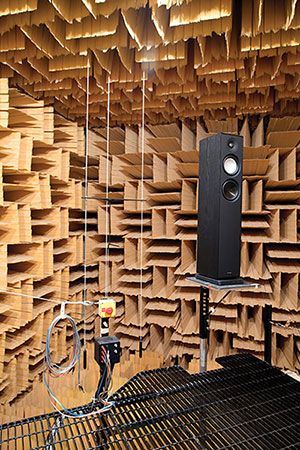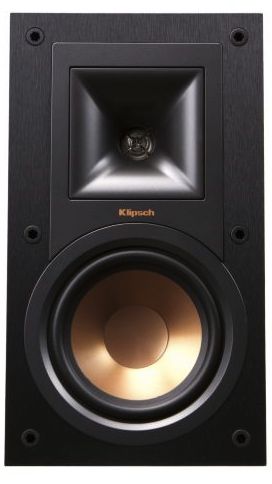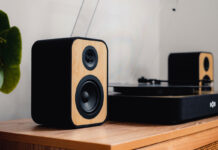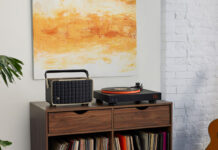
Marketing departments realized long ago that the majority of consumers do not want to be burdened with cumbersome math when purchasing stereo equipment. If you have ever been in the market for new speakers, chances are you have been indoctrinated to believe that watts should be the most important factor in your purchasing decision. More watts equal more volume, right? Not necessarily. Let’s bust some myths about watts and volume and look at the factors that actually determine how loud your speakers will be once you get them home.
What determines how loud speakers will be?
Decibels
Before we can dig into the question of how loud our speakers will be, we need to understand how volume is measured. Enter the Decibel (dB). Everything around us makes noise, from your refrigerator (50 dB), to a hair dryer (70-90 dB), or the Harley down the street (95-110dB).
 There is plenty of information online on the decibel level of various sounds and scientific consensus on what humans can safely subject their ears to without causing permanent damage. You can download excellent dB meter apps to your smartphone in the event you want to run some tests yourself, or would like to have a helpful tool when calibrating your home theatre system.
There is plenty of information online on the decibel level of various sounds and scientific consensus on what humans can safely subject their ears to without causing permanent damage. You can download excellent dB meter apps to your smartphone in the event you want to run some tests yourself, or would like to have a helpful tool when calibrating your home theatre system.
Speaker Sensitivity
Every speaker has the capacity to amplify sound, however, different manufacturers use their own unique approach to achieve this. Speakers may be crafted with different electrical components, use different materials, or harness new technologies, and that will impact how well the speaker translates the power being delivered from an amplifier into sound. This is defined as sensitivity, and is a critical factor when trying to understand the speaker’s potential for volume.
There is a standard test that manufacturers run with their speakers to determine sensitivity, which involves placing a microphone connected to a decibel meter one meter in front of a speaker, and measuring the sound pressure level output, in decibels, with one watt of power being delivered into the speaker. You will see this represented as dBs @ 1W/1 m or dBs @ 2.83V/m. (2.83V = 1 watt into an 8 Ohm speaker).
 Most speakers will fall somewhere between 80-90 dB @ 1W/1m, while some higher-end speakers will push sensitivity numbers into the 90s.
Most speakers will fall somewhere between 80-90 dB @ 1W/1m, while some higher-end speakers will push sensitivity numbers into the 90s.
Anechoic Chamber vs Room Sensitivity
When comparing speakers it is important to know you are comparing apples to apples. Some speakers are tested in an anechoic chamber, which is designed to ensure there is no reflected sound being picked up during the measurement, and some sensitivity ratings are noted as “room” which is an important distinction.
Room sensitivity will undoubtedly be a higher number, usually by about 3 dB, as it is picking up the additional sound being reflected in the room whereas an anechoic chamber is dead quiet with no chance of reflected sound.
 Other speaker manufacturers test sensitivity using a single frequency, which may artificially increase the dB reading, whereas a fair test would include a range of frequencies and averaged out, or a test tone such as pink noise. While the sensitivity rating is critical to understanding your speakers, it is equally important to seek out the details of what manufacturers are providing in their data.
Other speaker manufacturers test sensitivity using a single frequency, which may artificially increase the dB reading, whereas a fair test would include a range of frequencies and averaged out, or a test tone such as pink noise. While the sensitivity rating is critical to understanding your speakers, it is equally important to seek out the details of what manufacturers are providing in their data.
There are independent bodies that standardize tests and remove the ability of the manufacturers to provide misleading data to help you ensure the sensitivity ratings are accurate.
How Watts Increase Decibels
The reason watts do not directly equate to volume is because every speaker is different. Being empowered with the knowledge of our speaker sensitivity allows us to determine exactly how much power we will need to drive our speakers to a specific decibel level. Science has taught us that to increase the SPL of an audio signal by 3 dB, we need to double the watts. (For more on Watts, Amps and Ohs and how they play in to your home theatre, check out my recent blog on that topic.)Check out this table below to see how the sensitivity impacts the decibel level a speaker can output based on how many watts are being driven into it.
| Sensitivity | 82 dB | 88 dB | 92 dB |
| Watts | |||
| 1 | 82 | 88 | 92 |
| 2 | 85 | 91 | 95 |
| 4 | 88 | 94 | 98 |
| 8 | 91 | 97 | 101 |
| 16 | 94 | 100 | 104 |
| 32 | 97 | 103 | 107 |
| 64 | 100 | 106 | 110 |
| 128 | 103 | 109 | 113 |
| 256 | 106 | 112 | 116 |
| 512 | 109 | 115 | 119 |
We know that a stadium rock show is going to run between 110-120 dB, a volume that will generally leave your ears ringing after a couple hours of sustained listening. There are very few occasions where pushing our own home theatre speakers to this level will be necessary or probably desired. I enjoy my music loud, probably louder than most, and using a dB meter I find that an average of 100 – 105 dB is about as loud as I can comfortably listen.
If we look at our table, we can see that a speaker with a sensitivity rating of 82 dB @ 1W/1m will require 256 watts to reach 106 dB, whereas a speaker rated at 92 dB @ 1W/1m will only require 32 watts to achieve 107 dB.
This is a wide gap, and should start to clarify two things: why speaker sensitivity is such an important factor when choosing your speakers and matching amplifiers to them, and why high-end 40 watt per channel amplifiers can be far more expensive than an entry-level 100 watt receiver.
What Does It Mean For Me?
To figure out your situation, start with the sensitivity as noted in the specs, (__ dB @ 1W/1m) and for every three dB increase you need, double the watts. You also need to consider the amplification your speaker is designed to handle, because too much power will damage the coils. So, even if you have found a speaker you love, and figure out you need 256 watts to get it to the volume you want, if it can only handle 200 watts, you need to reconsider your choices.
 Distance and Room Size Impact Volume
Distance and Room Size Impact Volume
The numbers noted in the table above measure the sound pressure at 1 meter away from the speaker. Unless in a very small room, very few people will be listening to his or her speakers at that distance, so we need to factor in how distance impacts volume. If we go back to our anechoic chamber, and the physics of audio, we know that every time we double the distance our microphone sits from our speaker, we lose 6 decibels.
Room Gain
We also know that no one lives in an anechoic chamber, and you won’t experience the same dB loss that is experienced in a chamber due to a factor called “room gain.” Room gain increases the sound pressure in a space because sound reflects and bounces around the room, and is considered to be roughly a 3 dB bump in most spaces. A wide open space will result in less gain than a smaller space.
To break this down, if you want to build a system that will achieve 105 dB, in a room where your speakers will be 2 meters from the listening position, you need to ensure you have the power for your speakers to reach 108 dB based on table above. (108 db @ 1m, double the distance to 2 meters loses 6 dB, so the same speaker would be 102 dB @ 2m, room gain adds 3 dB = 105 dB)
 Assumptions About Room Size
Assumptions About Room Size
We can reasonably assume the following: the larger the space you are looking to fill with sound, the higher the sensitivity should be on your speakers. It is virtually impossible to take speakers that have a low sensitivity rating and amplify them to levels that could reasonably fill a large space. The table above shows us that a 82 dB @ 1W/1m would require 512 watts to achieve 110 dB one meter away. It’s probably going to be cheaper and easier to find a speaker with a higher sensitivity rating than it would be to find a 500 watt amp.
Volume Doesn’t Equal Quality
I want to clarify that there is no correlation between volume and sound quality. For me, I know I’m listening to a good speaker when I can increase the volume to that sweet spot of 100-105 dB and the music doesn’t sound loud. That may not make sense, but what I am referring to is the speaker is not stressing my ears or brain with noise. The sound is clean, it’s clear, and there are no frequencies that grind the ears or expose the speaker’s weaknesses by distorting.
As always, when you are in the market for new speakers you should audition as many as possible and land on the pair that matches your ear, and your budget. Best Buy Canada is a great place to start your search. The info in this piece should provide you with the knowledge to confidently match your speakers to an amplifier and understand what volume level you should expect from your new rig.



